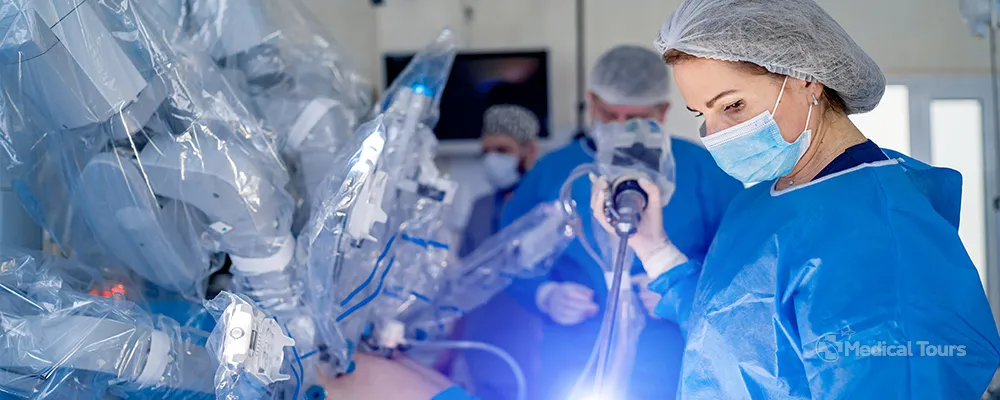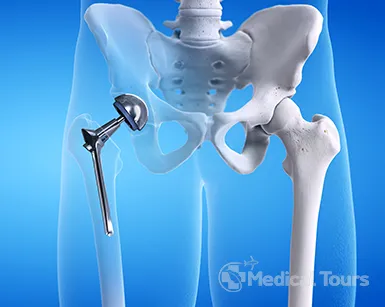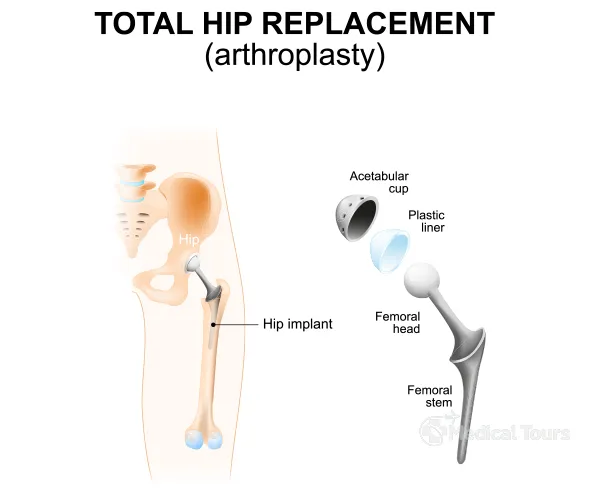About Robotic Orthopedic Surgery
Robotic orthopedic surgery or robotically assisted surgery is a minimally invasive procedure designed to improve surgeons' abilities to perform open Orthopedic surgeries. The two robotic systems are haptic (surgeon guided) and autonomous. The other type of surgery is passive surgery systems, which have recently gained popularity among surgeons. The surgery improves surgeon precision and employs surgical robots, such as active systems, during the procedure. They provide more precise preparation of bony surfaces in orthopedic surgery.
Advantages of robotic orthopedic surgery
- Long-term function may be improved because of the surgery.
- The surgery allows for more precise placement of the implant, which may result in a more natural feeling after the procedure is completed.
- The surgery improved safety, lowering the risk of injury to neighboring tissues.
- The surgery can also be performed in a clean room, which reduces the risk of infection during the procedure.
- Cosmesis has improved, and scarring has decreased.
- There is also less pain and discomfort after surgery.
Robotic Hip Replacement Surgery
Persistent hip pain for more than three months can result in a permanent problem. The most common causes of this problem are hip impingement, torn labrum, and osteoarthritis or arthritis. To relieve hip pain, various surgeries such as total hip replacement, arthroscopic hip surgery, and hip resurfacing surgery can be performed. Modern robotic surgery is the most successful orthopedic surgery.
The goal of hip arthroscopic surgery is to reduce hip joint inflammation and pain caused by wear, arthritis, or injury. Arthroscopic hip surgery and total hip replacement surgery are the two surgical procedures that are specifically designed to repair damaged parts or portions of the hip joint.
Total Hip Replacement Surgery
It is the most common orthopedic procedure. The surgery involves the removal of the femoral head (thigh bone) and replacement of the affected area's ball and socket joint with advanced artificial implants. These implants are extremely durable and will last the patient's entire life. The following procedures are used to reduce recovery time:
- Ceramic hip implants- Ceramic hip implants are extremely smooth and are meant to reduce new joint wear and strain.
- Direct anterior muscle separating arthroplasty- Rather than cutting through the hip muscles, the surgeon does surgery by operating in between them.
- Short stem hip implant- In comparison to prior models, these have shorter stems and are intended for tiny incision procedures.
Robotic Hip Arthroscopy
When there is hip pain caused by other tissues or broken cartilage around the hip joint, this minimally invasive surgery is performed. The goal is to clear debris from the hip joint and reduce inflammation as a result. The procedure can also help with the painful symptoms of a variety of conditions that damage the articular cartilage, soft tissues around the hip joint, or the labrum.
Robotic Knee Replacement Surgery
The procedure is done to treat discomfort from chronic knee arthritis or a knee injury. Joint replacement (reconstructive surgery) is a surgical procedure that is used to relieve joint discomfort caused by bone and cartilage degeneration. Knee resurfacing and replacement operations are used to remove worn-out surfaces of the knee using the most up-to-date and innovative implant technology. These are mostly recommended for the treatment of knee arthritis. The following are some of the knee surgery options:
Arthroscopic Knee Surgery
Makoplasty Partial Knee Resurfacing/ Replacement
Arthroscopic Knee Surgery
The damaged knee is repaired using a minimally invasive procedure during this surgery. During the surgical procedure, the surgeon examines the joint damage with fiber optic cameras and long tools. The surgery requires few incisions, which reduces the recovery time. The loose bodies are removed from the knee joint, allowing the damaged and torn cartilage and ligaments to heal.
Makoplasty Partial Knee Resurfacing/ Replacement
This advanced procedure employs a robotic arm to aid in the preparation and planning of the knee for the use of knee replacement implants. Makoplasty can alleviate the pain of mid-stage knee osteoarthritis. Partially surfacing the knee (unicompartmental surgery) focuses on the damaged parts of the knee and helps to restore normal knee function. The healthy cartilage, ligaments, and bones are in excellent condition. The surgery relieves knee pain, strengthens the knee, provides natural knee function with improved motion and alignment, and improves balance.
Total Knee Replacement
This surgery is used to treat severe degenerative conditions of the knee joint. The advanced artificial joints are designed to mimic the gliding and rolling motion of the knee. The surgeon modifies the patient's joint based on age, activity level, and body type using a variety of options.
Different Procedure of Robot-Assisted Surgery
Robot-assisted surgery is used to treat a wide range of conditions in almost every field. The following are the various categories of robotic-assisted surgery, whether in the field of gynecology or urology:
- Surgery in general
- Cardiothoracic surgery
- Urologic surgical procedures
- Brain surgery
- Surgery on the neck
- Cardiovascular surgery
Robot-assisted surgery is used in the field of orthopedics to remove diseased or damaged bone fragments. It is capable of correcting spinal deformities such as scoliosis and kyphosis. Total knee replacement and total hip replacement are the two most common robotic-assisted surgeries.
The Test Required for Robotic-Assisted Orthopedic Surgery
The tests that are required for robot-assisted total knee replacement and hip replacement surgery are:
- MRI
- CT scan
- X rays of knee area
- Preoperative blood tests
Preparations for the surgery
Before the surgery, the surgeon will advise the patient to make some lifestyle changes. Some of them will be as follows:
- Tobacco cessation
- Abstinence from alcohol
- avoiding any blood thinning agents
- avoiding over-the-counter pain relievers
- From the night before surgery, no solid or liquid food should be consumed.
If a patient must take certain medications that cannot be avoided, they must notify their doctor and consume the medication with as little water as possible.
Procedure
- A total knee/hip replacement surgery takes one hour and thirty minutes.
- Robots do not perform all aspects of orthopedic surgery. The surgical team is in charge of administering the system and guiding it through the various stages of the surgery.
- The arms of the system, which are attached to various surgical instruments, also have a small camera and magnifying lenses. This allows the surgeon to gain access to the patient's internal organs.
- The incisions are made by the surgeon using the system's instructions. Robot-assisted surgery incisions are very precise and thus do not need to be large. Skin incisions may even be unnecessary in some cases.
- The surgeon makes correctional repairs while the images are projected live on a large screen. The surgeon has more leeway in total knee/hip replacement surgery that involves the use of implants. Furthermore, the implants are more precisely placed, which reduces the likelihood of implant loosening or dislocation following surgery.
- Robot assisted surgery is beneficial to surgeons, particularly orthopedic surgeons, because standard orthopedic surgical procedures are time-consuming and exhausting. This can sometimes have an impact on the surgical process. As a result, in complicated orthopedic cases, a surgeon will always choose robotic assisted orthopedic surgery.
Recovery
The patient will feel very little discomfort when he or she wakes up after the surgery. A total knee/hip replacement surgery will require a one-week hospital stay. During this time, the patient is instructed on how to use the newly attached implants. Assistive devices are provided, and physiotherapy sessions begin the next day.
The patient is given a set of instructions before being discharged. Some of them are as follows:
- Taking medications as prescribed.
- Maintaining an elevated knee position.
- Physiotherapy exercises on a regular basis.
- Taking precautions to avoid tripping or falling.
- Walking only with the assistance of assistive devices.
- Maintaining a clean and dry surgical site at all times.
Although there is no improvement in recovery time, robot assisted orthopedic surgery reduces risks to a greater extent. Because it is performed by a robotic system controlled by a team of surgeons, complications such as nerve damage or implant dislocation are avoided.
Complications
Robot-assisted orthopedic surgery, like all surgical interventions, has risks. These complications may be reduced with the assistance of robots. They are as follows:
- Excessive bruising.
- Poor system management caused damage to the surrounding areas.
- Because of the small incisions, a 'port site hernia' developed.
How much does robotic orthopedic surgery cost in India?
Robotic orthopedic surgery cost in India is lower than in other countries and this is another reason which makes it a preferred destination for those who opt for robotic orthopedic surgery. Robot-assisted surgery cost in India starts from USD 2,000 (INR 1,58,553) and may range reaches its limit at USD 10,000 (INR 7,92,766). The Cost of the surgery differs because of many factors like surgeon, hospital as well as city.
Robotic surgery is medical procedure that is used in different areas. For instance, it is used by medical experts during surgery.
Test that are required to different types of robotic surgery are as follows;
- MRI
- CT Scan
- X rays of knee area
- Preoperative blood tests
One need to do certain things before going for surgery and they are as follows;
- Do not drink alcohol.
- Quit tobacco
- Refrain from; over the counter painkillers
- Refrain from; any blood thinning agents
- Do not take any type of solid or liquid food from the night before the surgery.
The success ratio of robotic surgery depends on many factors. These factors can be;
- Place of the surgery performed on the body
- Surgeon's experience
- Prior surgery the patient has had
There are some of the very similar risk that may be similar to risks of conventional open surgery. These can be such as a small risk of infection and other complications.



